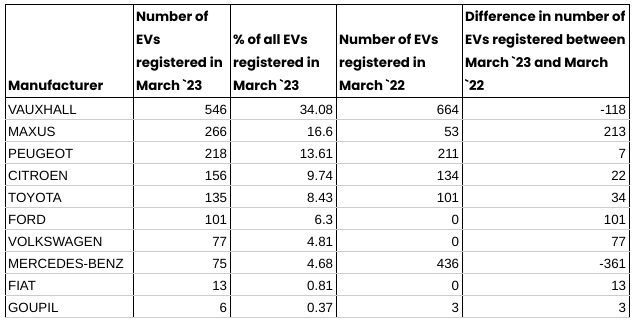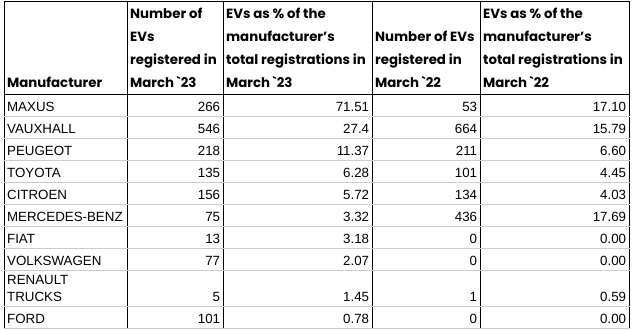Royal Mail takes delivery of electric vans as fleets go electric
Electric vans share of the Uk’s van market held steady in March, with 5% of all new registrations being fully electric. New electric registrations continue to be buoyed by commercial fleets taking advantage of the grants still available for businesses looking to make the switch. This month, Royal Mail took delivery of 82 e-vans at its Mansfield depot, and Bury council has added 15 new e-vans to its fleet. Those businesses who choose an electric van tend to keep them; according to Arval UK 90% of businesses which obtain an e-van using their medium term rental option choose to keep them at the end of their lease.
⚡ What Our Data Shows
Ciara Cook, Research and Policy Officer at New AutoMotive, said:
“New AutoMotive welcomes the government implementing our recommendation to increase targets around e-van take-up in the Zero Emission Vehicle (ZEV) Mandate. It is positive to see higher, revised targets released in the government’s final consultation before the policy is finalised ahead of its launch in 2024. ”
“These more ambitious targets will help to ensure that the ZEV Mandate pushes the van market forward, rather than hindering it or simply acting as a backstop. It is also encouraging to see the government push the target EV market share to 70% by 2030 - a move that will help ensure that hybrids will not be a significant element of the road to 2035. However, the 70% target will still lead to 30% of the market share going to hybrids, despite them accounting for less than 1% of the market this month.”
“The government needs to go further and discount hybrids entirely, focussing on close to 100% zero emission vehicles in the van market by 2030. This will simplify the message to the market, helping it to react accordingly. The government should also ensure that the ZEV Mandate is clear and simple, with no way to substitute ICE vans for electric vans.”
The full data release is available here. You can view the data on our interactive dashboard, here.
📈 UK market overview
The new van market in March remained fairly similar to the last several months. There has been a slight drop in overall registrations compared to March 2023 - but only very slight. Once again, the registration of nearly 33,000 new diesel vans, each of which will be polluting our roads for over a decade to come, demonstrates the significant scale of the task ahead.
For the full data, and year-on-year comparisons, refer to table 1 in the full release.
🚗 The race for EV market share
Those manufacturers we have come to expect to see at the top of the table continue to cement their lead in the market. Vauxhall e-vans accounted for a third of the market this month. Vauxhall was followed by Maxus, another marque which has begun to make a significant mark in the electric van market, who were responsible for 17% of all new van registrations. Further down the table we have Mercedes-Benz, who made up 5% of the market and saw a considerable decrease in the number of vans registered compared with March last year.
📊 The brands who are quickest to electrify
Maxus continues to lead this table by a significant margin, with three in every four of their registrations being fully electric in March. The company continues to have a significant lead on Vauxhall, who were second in the table with 27% of their vehicles electric. Looking at higher volume manufacturers, we see Mercedes-Benz and Ford still on the bottom half of this table at 6th and 10th place respectively.
We exclude brands that are 100% electric from this table since they do not need to electrify their sales. For the full data, refer to table 2 in the full release.
Notes
About Electric Van Count
Electric Van Count is a monthly data series from New AutoMotive, a not-for-profit independent transport research organisation with a mission to accelerate and support the UK’s transition to electric vehicles. You can find out more about New AutoMotive by visiting www.newautomotive.org/mission
Electric Van Count provides an overview of the newly licensed vans. It is released monthly, on the second Monday of each month, providing data on the previous month’s newly licensed vans. In the UK, vehicles must be licensed (also known as registered) to be legally driven on UK roads.
We provide an overview of the state of the market, showing the number of cars registered by each manufacturer, broken down by fuel type. This provides a new way to track the transition to Electric vans in the UK.
Visit our interactive data dashboard here: https://newautomotive.org/evc
For more background information on the statistics we provide, you can read our blog about the race for EV market share: www.newautomotive.org/blog/the-race-for-ev-market-share-is-under-way
Data sources & methodology
The data shows the number of type N1 vehicles (vehicles for the carriage of goods with a maximum mass not exceeding 3.5 tonnes) in the DVLA’s vehicle licensing database as it stands on, or shortly after, the 1st day of the month. The DVLA’s vehicle licensing database is the legal record of all vehicles licensed for use in the UK. We obtain the data from the DVLA’s vehicle enquiry service API, and the DVSA’s MOT history API.
The data covers all vans with a standard form UK vehicle registration mark (VRM, i.e. the vehicle’s number plate), but does not capture any vehicles with personalised VRMs.
Terminology
We use the following terms to refer to vehicle fuel types:
Pure electric: battery electric, or other purely electric-powered vehicles (such as hydrogen). These are vehicles where the drivetrain of the vehicle is only electric, with no facility to drive using a fossil fuelled engine.
Hybrid: vehicles that have the ability to drive under electric power or under fossil fuel power. These include vehicles classified by the DVLA as “hybrid electric”, “electric diesel”, for example.
Q&A
Why are the numbers different from other organisations, such as the SMMT?
Our numbers are typically slightly different from those published by the SMMT. We cannot speculate as to why this is because the SMMT do not publish the methodology for obtaining their vehicle data.
Our data is based on the DVLA’s legal record of vehicles licensed as it stands on the first of the month.
Our methodology does not capture newly registered vehicles with a personalised number plate. These take longer to appear in our database, and are not included in the monthly release. We do not believe that these are a statistically significant part of the market.
Will you make this data open and accessible to more organisations?
Yes, we are happy to supply the data to anyone where doing so will not conflict with our mission. We encourage people to reach out to us on data@newautomotive.org.





